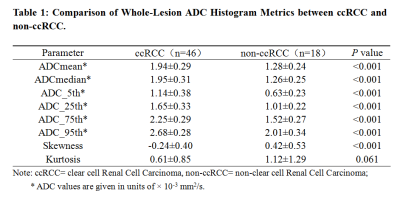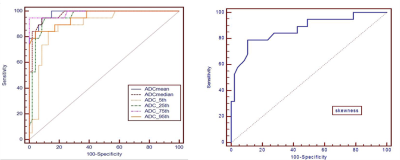4676
Small (< 4 cm) Renal Masses:Differentiation of clear cell Renal Cell Carcinoma from non-clear cell Renal Cell Carcinoma Using Whole Tumor ADC Histogram Analysis at r-Fov DWI1Radiology, Tongji Hospital, Tongji Medical College, Huazhong University of Science and Technology, Wu Han, China
Synopsis
The combination of r-FOV DWI and the whole-lesion histogram analysis method may help in the interpretation of DWI of small renal masses and determine the optimal ADC parameter for quantitative assessment. The 75th percentile ADC value was more reliable than other histogram parameter values in distinguishing clear cell from non-clear cell RCCs with high sensitivity and specificity, potentially improving the accuracy of pretreatment diagnosis and selection of clinical therapy.
Purpose
To determine the utility of ADC histogram analysis derived from high-resolution r-FOV DWI for differentiation of clear cell renal cell carcinoma (ccRCC) and non-clear cell renal cell carcinoma (non-ccRCC).Introduction
Previously studies have demonstrated the whole-lesion histogram analysis could enable elimination of sample bias and enhanced assessment of the intromission heterogeneity1. The reduced field-of-view (r-FOV) DWI, a novel developed DWI sequences, which has been recognized valuable in providing high resolution and high-quality DWI in small structures by reducing the number of required k-space lines2. The purpose of this study was to explore the diagnostic performance of whole-lesion ADC histogram parameters derived from high-resolution r-FOV DWI in the differentiation of ccRCC and non-ccRCC.Materials and Methods
This Institutional Review Board-approved, retrospective study included 64 patients with either pathologic analysis-confirmed ccRCC (n=46) or non-ccRCC (n=18). All patients underwent preoperative r-FOV DWI (b=600s/mm2) at 3T MRI. The whole-lesion ADC assessments were performed for each patient. All Histogram-derived ADC parameters between ccRCC and non- ccRCC were compared by using the Student’s t test or Mann–Whitney U test. Receiver operating characteristic analysis was used for statistical evaluations.Results
ADC histograms of the non-ccRCC group were mostly skewed positively, while the curves of ccRCC were largely skewed negatively. Mean ADC, median ADC, 5th percentile ADC, 25th percentile ADC, 75th percentile ADC, 95th percentile ADC were significantly lower in non-ccRCC (all P < 0.001), while skewness was significantly higher in non-ccRCC (P<0.001) (Fig. 1). 75th percentile ADC achieved the highest AUC (0.987) in differentiating ccRCC and non-ccRCC, with a cutoff value of 1.81× 10-3 mm2/s, and a sensitivity of 100.0% and a specificity of 94.7% (Fig. 2).Discussion and conclusion
In this study, the preliminary date from our study demonstrate that the combination of r-FOV DWI and the whole-lesion histogram analysis method may help in the interpretation of DWI of small renal masses and determine the optimal ADC parameter for quantitative assessment. The 75th percentile ADC value was more reliable than other histogram parameter values in distinguishing clear cell from non-clear cell RCCs with high sensitivity and specificity, potentially improving the accuracy of pretreatment diagnosis and selection of clinical therapy.Acknowledgements
No acknowledgement found.References
1. Donati O F, Mazaheri Y, Afaq A, et al. Prostate cancer aggressiveness: assessment with whole-lesion histogram analysis of the apparent diffusion coefficient[J]. Radiology,2014,271(1):143-152.
2. Ma C, Li Y, Pan C, et al. High resolution diffusion weighted magnetic resonance imaging of the pancreas using reduced field of view single-shot echo-planar imaging at 3 T[J]. Magnetic Resonance Imaging,2014,32(2):125-131.

